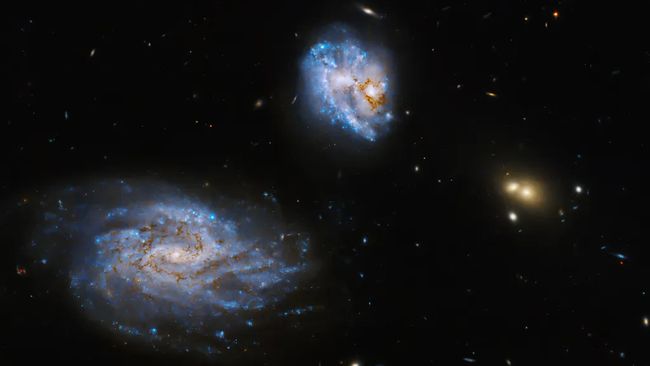Hubble Space Telescope Observes Illuminated Stars in Colliding Galaxies
The Hubble Space Telescope has captured a mesmerizing sight of star formation illuminating a duo of merging galaxies.
Recently, the Hubble Space Telescope captured an image of a pair of merging galaxies, UGC 05028 and UGC 05029, also known as Arp 300. These spiral galaxies are currently in the process of merging, resulting in a fascinating display of star formation. The smaller galaxy, UGC 05028, has been influenced by the strong gravitational pull of its larger companion, UGC 05029, causing it to undergo asymmetrical and irregular structural changes. This unique structure is not easily observable from ground-based telescopes but is clearly visible in the new image from NASA’s Hubble Space Telescope.

From the perspective of the Hubble Space Telescope, both galaxies appear face-on, allowing for a clear view of their bright central bulges and spiral arms. When observed face-on, a spiral galaxy appears circular and disc-shaped, in contrast to its appearance when viewed from the side, known as an edge-on view, where it appears more flattened and oval-shaped. In the new Hubble image, there is also an example of an edge-on galaxy located below UGC 05029.
UGC 05028 exhibits a bright knot situated southeast of its core, which may be the result of an ongoing galactic merger. Scientists predict that once this merger is complete, the remnants of the other galaxy will be fully absorbed by UGC 05028, leading to the formation of a prominent central bulge similar to that seen in UGC 05029. This process will also fuel the birth of new stars.
The impact of the merging galaxies is evident in UGC 05029, where rapid star formation has been triggered. The interaction between the two merging galaxies has resulted in the formation of numerous hot, blue giant stars along UGC 05029’s spiral arms, particularly in close proximity to its companion, UGC 05028. This phenomenon highlights the dynamic nature of star formation in response to galactic mergers.
Hubble directed its attention towards Arp 300 with the aim of gaining a deeper comprehension of the correlation between the physical attributes of UGC 05028 and UGC 05029, as well as the dynamics of their star formation. In the process, the space telescope also documented several additional entities within the galactic vicinity. Among these, a series of five remote background galaxies were observed clustered together towards the lower section of the image, which NASA unveiled on January 22nd.
Do not forget to share your opinion with us to provide you with the best posts !



0 Comments